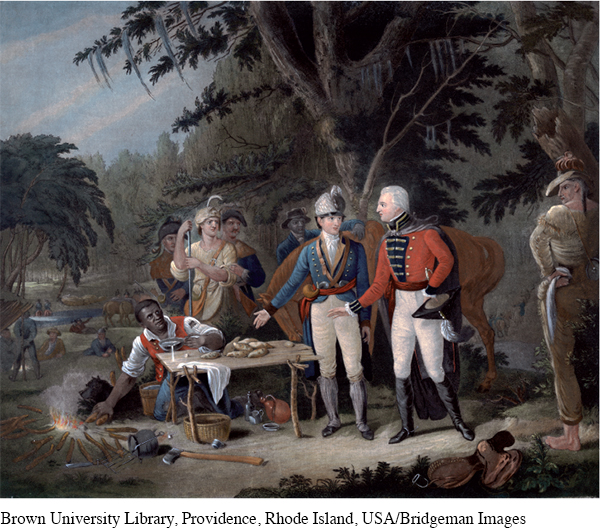War Rages in the South
Meanwhile British troops sought to regain control of southern states from Georgia to Virginia. British troops captured Savannah, Georgia, in 1778 and soon extended their control over the entire state. When General Clinton was called north later that year, he left the southern campaign in the hands of Lord Charles Cornwallis.
In May 1780, General Cornwallis reclaimed Charleston, South Carolina. He then evicted patriots from the city, purged them from the state government, gained military control of the state, and imposed loyalty oaths on all Carolinians able to fight. To aid his efforts, local loyalists organized militias to battle patriots in the interior. Banastre Tarleton led one especially vicious company of loyalists who slaughtered civilians and murdered many who surrendered. In retaliation, patriot planter Thomas Sumter organized 800 men who showed a similar disregard for regular army procedures, raiding largely defenseless loyalist settlements near Hanging Rock, South Carolina, in August 1780.
As retaliatory violence erupted in the interior of South Carolina, General Gates marched his Continental troops south to join 2,000 militiamen from Virginia and North Carolina. But his troops were exhausted and short of food, and on August 16 Cornwallis won a smashing victory against the combined patriot forces at Camden, South Carolina (see Map 6.2). Soon after news of Gates’s defeat reached General Washington, he heard that Benedict Arnold, commander at West Point, had defected to the British.
Suddenly, British chances for victory seemed more hopeful. Cornwallis was in control of Georgia and South Carolina, and local loyalists were eager to gain control of the southern countryside. Meanwhile Continental soldiers in the North mutinied in early 1780 over enlistment terms and pay. Patriot morale was low, funds were scarce, and civilians were growing weary of the war.
Yet somehow the patriots prevailed. A combination of luck, strong leadership, and French support turned the tide. In October 1780, when Continental hopes looked especially bleak, a group of 800 frontier sharpshooters routed loyalist troops at King’s Mountain in South Carolina. The victory kept Cornwallis from advancing into North Carolina and gave the Continentals a chance to regroup.
Shortly after the battle at King’s Mountain, Washington sent General Nathanael Greene to replace Gates as head of southern operations. Taking advice from local militia leaders like Daniel Morgan and Francis Marion, Greene divided his limited force into even smaller units. Marion and Morgan each led 300 Continental soldiers into the South Carolina backcountry, picking up hundreds of local militiamen along the way. At the village of Cowpens, Morgan inflicted a devastating defeat on Tarleton’s much larger force.

Cornwallis, enraged at the patriot victory, pursued Continental forces as they retreated. But Cornwallis’s troops had outrun their cannons, and Greene circled back and attacked them at Guilford Court House. Although Cornwallis eventually forced the Continentals to withdraw from the battlefield, British troops suffered enormous losses. In August 1781, frustrated at the ease with which patriot forces still found local support in the South, he hunkered down in Yorktown on the Virginia coast and waited for reinforcements from New York.
Washington now coordinated strategy with his French allies. Comte de Rochambeau marched 5,000 troops south from Rhode Island to Virginia as General Lafayette led his troops south along Virginia’s eastern shore. At the same time, French naval ships headed north from the West Indies. One unit cut off a British fleet trying to resupply Cornwallis by sea. Another joined up with American privateers to bombard Cornwallis’s forces. By mid-October, British supplies had run out, and it was clear that reinforcements would not be forthcoming. On October 19, 1781, the British army admitted defeat.
Exploring American HistoriesPrinted Page 195
Exploring American Histories Value EditionPrinted Page 145
Chapter Timeline